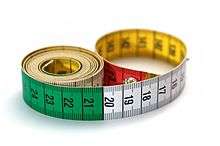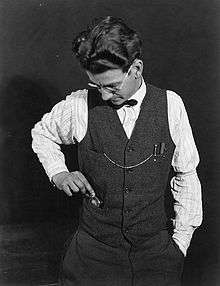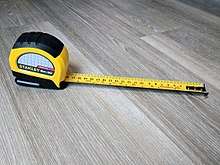Tape measure




A tape measure or measuring tape is a flexible ruler and used to measure distance.
It consists of a ribbon of cloth, plastic, fibre glass, or metal strip with linear-measurement markings. It is a common measuring tool. Its design allows for a measure of great length to be easily carried in pocket or toolkit and permits one to measure around curves or corners. Today it is ubiquitous, even appearing in miniature form as a keychain fob, or novelty item. Surveyors use tape measures in lengths of over 100 m.
Types
There are two basic types of tape measures with cases, spring return pocket tape measures and long tape measures. Spring return pocket tape measures will generally fit in a pocket. They are small, the case is up to about three inches across. The tape is returned to the case by a spring mechanism. Pocket tape measures have a tape one foot to fifteen feet in length and ¼ to ¾ inches across. When most people think of a tape measure, they are thinking of the pocket tape measure.
A second tape measure design is what is called the long tape. These are cased tape measures with tapes of 25, 50, 75, 100, 200, 300, and even 500 feet in length, designed for engineers and builders. Because surveying was usually done in rods, surveyors use long tapes of 33 feet (2 rods), and 66 feet (4 rods). Surveyors also used 49½ feet of a 50-foot tape for 3 rods and 99 feet of a 100-foot tape measure for 6 rods. Long tapes instead of being returned by a spring, were usually returned by hand crank.
Tape measures are often designed for specific uses or trades. Tapes may have different scales, be made of different materials, and be of different lengths depending on the use it is intended for. Tape measures that were intended for use in tailoring or dressmaking were made from flexible cloth or plastic. They are named “sewing tape”. These types of tape measures were mainly used for the measuring of the subject’s waist line. Today, measuring tapes made for sewing are made of fiberglass, which does not tear or stretch as easily. Measuring tapes designed for carpentry or construction often use a stiff, curved metallic ribbon that can remain stiff and straight when extended, but retracts into a coil for convenient storage. This type of tape measure will have a floating tang or hook on the end to aid measuring. The tang is connected to the tape with loose rivets through oval holes, and can move a distance equal to its thickness, to provide both inside and outside measurements that are accurate.[1] A tape measure of 25 or even 100 feet can wind into a relatively small container. The self-marking tape measure allows the user an accurate one hand measure.
History
The first record of people using a measuring device was by the Romans using marked strips of leather, but this was more like a regular ruler than a tape measure.
On December 6, 1864 patent #45,372 was issued to William H. Bangs of West Meriden, Connecticut. Bang's rule was the first attempt in the United States to make a spring return pocket tape measure. The tape could be stopped at any point and held by the mechanism. The tape could be returned to the case by sliding a button on the side of the case which then allowed the spring to pull the tape back into the case. [2]

On 3 January 1922, Hiram A. Farrand received patent #1,402,589 for his concave-convex tape, a major improvement for spring pocket tape measures.[3] Between 1922 and December 1926, Farrand experimented with the help of The Hipolito Company in Cainta Autoplex.[4] It is there Farrand and William Wentworth Brown began mass-producing the tape measure.[5] Their product was later sold to Stanley Works. It was Farrand's concave-convex tape that went on to become the standard for the majority of pocket tape measure tapes today
The first patented for a long tape measure in the United States was patent #29,096 issued July 10, 1860 to William H. Paine of Sheboygan, Wisconsin [6], and produced by George M. Eddy and Company of Brooklyn, New York. This tape had no increments on it. It accurately measured only a distance equal to the total length of the tape from beginning to end marker, a brass piece attached to the tape at a measured distance. The measured length was marked on the case or crank.
Later, by the early 1870s, Justus Roe of Patchogue, New York added rivets attaching small brass washers, to the tape to mark inches and feet. They were attached ever inch in the first and last foot and every foot from one to the end of the last foot. A small brass tag, marked with a number indicating the number of feet to that point, was attached every five feet. This feature was never patented, but Justus Roe and Sons produced tape measures, "Roe Electric Reel Tape Measures", with this feature until 1895 when they started etching or stamping increments and numbers on the tapes. (The "electric" part of the name was purely an affectation; there was nothing electrical about it.)
Design
The basic design on which all modern spring tape measures are built can trace its origins back to an 1864 patent by a West Meriden, Connecticut resident named William H. Bangs Jr. According to the text of his patent, Bang's tape measure was an improvement on other versions previously designed. [7]
The spring tape measure has existed in the U.S. since Bang's patent in 1864, but its usage did not become very popular due to the difficulty in communication from one town to another and the expense of the tape measure. In the late 1920s, carpenters began slowly adopting H. A. Farrand's design as the one more commonly used. Farrand's new design was a concave/convex tape made of metal which would stand straight out a distance of four to six feet. This design is the basis for most modern pocket tape measures used today.
With the mass production of the integrated circuit (IC) the tape measure has also entered into the digital age with the digital tape measure. Some incorporate a digital screen to give measurement readouts in multiple formats. An early patent for this type of measure was published in 1977.[8]
There are also other styles of tape measures that have incorporated lasers and ultrasonic technology to measure the distance of an object with fairly reliable accuracy.
Tape measure's often have black and red measurements on a yellow background as this is the optimal color combination for readability. [9]
United States
Justus Roe, a surveyor and tape-maker by trade, made the longest tape measure in 1956, at 600 feet (183 m).[10]
The Northern Virginia Surveyors Association presented the 600-foot, gold-plated surveyor's tape measure to Mickey Mantle in 1956.[11]
Some tapes sold in the United States have additional marks in the shape of small black diamonds, which appear every 19.2 inches (488 mm). These are used to mark out equal spacing for joists (five joists or trusses per standard 8-foot (2,438 mm) length of building material).
Many tapes also have special markings every 16 inches (406 mm), which is a standard interval for studs in construction. Three spaces of 16 inches make exactly 4 feet (1,219 mm) which is the commercial width of a sheet of plywood, gyprock or particle board.
It should also be mentioned that the sale of dual metric/customary scale tapes is slowly becoming common in the United States. For example, in some Walmarts there are Hyper Tough brand tapes[12] available in US customary units and Metric units. Unlike US rulers, of which an overwhelming majority contain both cm and inch scales, tape measures are longer and thus traditionally have had scales in both inches and feet + inches. So, inclusion of a metric scale requires the measuring device to either contain 3 scales of measure or the elimination of one of the customary scales.

The use of millimeter only tape measures for housing construction is a part of the US metric building code[13][14]. The use of centimeters is not allowed. Millimeters produce whole (integer) numbers, reduce arithmetic errors, decreasing scrap. Australia, Bangladesh, Botswana, Cameroon, India, Kenya, Mauritius, New Zealand, Pakistan, South Africa, United Kingdom, and Zimbabwe all use millimeters only as their unit for building construction.[15] The separation between studs is 600 millimeters which has 24 different divisors easing calculation. The metric roll-up tape shown is a millimeter only tape measure. The dual scale Stanley tape measure is US inches and centimeters.
United Kingdom
Tape measures sold in the UK often have dual scales for metric and imperial units. Like the American tape measures described above, they also have markings every 16 in (40.6 cm) and 19.2 in (48.8 cm).
Canada
Tape measures sold in Canada often have dual scales for metric and imperial units. All tapes in imperial units have markings every 16 in (40.6 cm), but not at every 19.2 in (48.8 cm).
In surveying
Tapes are used in surveying for measuring Horizontal, vertical or slope distances. Tapes are issued in various lengths and widths and graduated in variety of ways.[16] The measuring tapes used for surveying purposes are classified in 4 types according to the material from which they are manufactured:
- Linen or Cloth Tape. It is made of linen cloth with brass handle at zero end whose length is included in the tape length. It is very light and handy, but cannot withstand much wear and tear. So it cannot be used for accurate work. It is little used in surveying except for taking subsidiary measurements like offsets.
- Metallic Tape. The tape is reinforced with copper wires to prevent stretching or twisting of fibers and is then called as metallic tape. They are available in many lengths but tapes of 20 m and 30 m are more commonly used.[17]
- Steel Tape. It is made of steel ribbon varying in width from 6 mm to 16 mm. It is available in lengths of 1, 2, 10, 30 and 50 meters. It cannot withstand rough usage and therefore it should be used with great care.
- Invar Tape. It is made of an alloy of steel (64%) and nickel (36%). It is 6 mm wide and is available in lengths of 30 m, 50 m and 100 m. It is costly and delicate and should be thus handled with great care.[18]
References
- ↑ Aird, Forbes (1999). Mechanic’s guide to precision measuring tools. Osceola, WI: MBI Pub. Co. p. 18. ISBN 9780760305454.
- ↑ U. S. Patent Full-Text Database Number Search, Patent #45,372 Retrieved on 23 October, 2017.
- ↑ US 1402589, Hiram A. Farrand, "Rule", issued 3 January 1922
- ↑ Hiram A. Farrand Inc. (Dec 1930). Popular Science. Popular Science Monthly. Retrieved 3 November 2011.
- ↑ Walter W. Jacob (Sep 2004). "Stanley Advertising and Imprinted Tape Rules". The Chronicle of the Early American Industries Association. Retrieved 3 November 2011.
- ↑ U. S. Patent Full-Text Database Number Search, Patent #29,096 Retrieved 23 December, 2017.
- ↑ U. S. Patent Full-Text Database Number Search, Patent #45,372 Retrieved 23 October, 2017.
- ↑ "Electronic read out tape measure". Google Patents. 21 June 1977. Retrieved 3 January 2015.
- ↑ "Optimal Colors to Improve Readability for People with Dyslexia - Text Customization for Readability Online Symposium". www.w3.org. Retrieved 2017-09-14.
- ↑ "Suffolk County News, Via the Grapevine" (PDF). 13 July 1956.
- ↑ Jane Leavy (2010). The Last Boy: Mickey Mantle and the End of America's Childhood. HarperCollins. p. 91. ISBN 978-0-06-088352-2.
- ↑ "HYPER-TOUGH".
- ↑ Metric Design Guide (PBS-PQ260) September 1995 Public Buildings Service U.S. General Services Administration
- ↑ Metric Implementation in US Construction Andrew J. Holland University of Florida Master's Thesis 1997
- ↑ The Dimensions of The Cosmos Randy Bancroft Outskirts Press 2016 pg 13
- ↑ "Surveying tapes". www.tpub.com.
- ↑ book on surveying by "Dr. B.c Punmia and Ashok Kumar Jain"
- ↑ surveying volume 1 by Prof. C.L Kochher, page no. 17
External links
- Various types of measuring tapes and construction materials

- "Directive 2014/32/EU". 26 February 2014.
on the harmonisation of the laws of the Member States relating to the making available on the market of measuring instruments (recast)